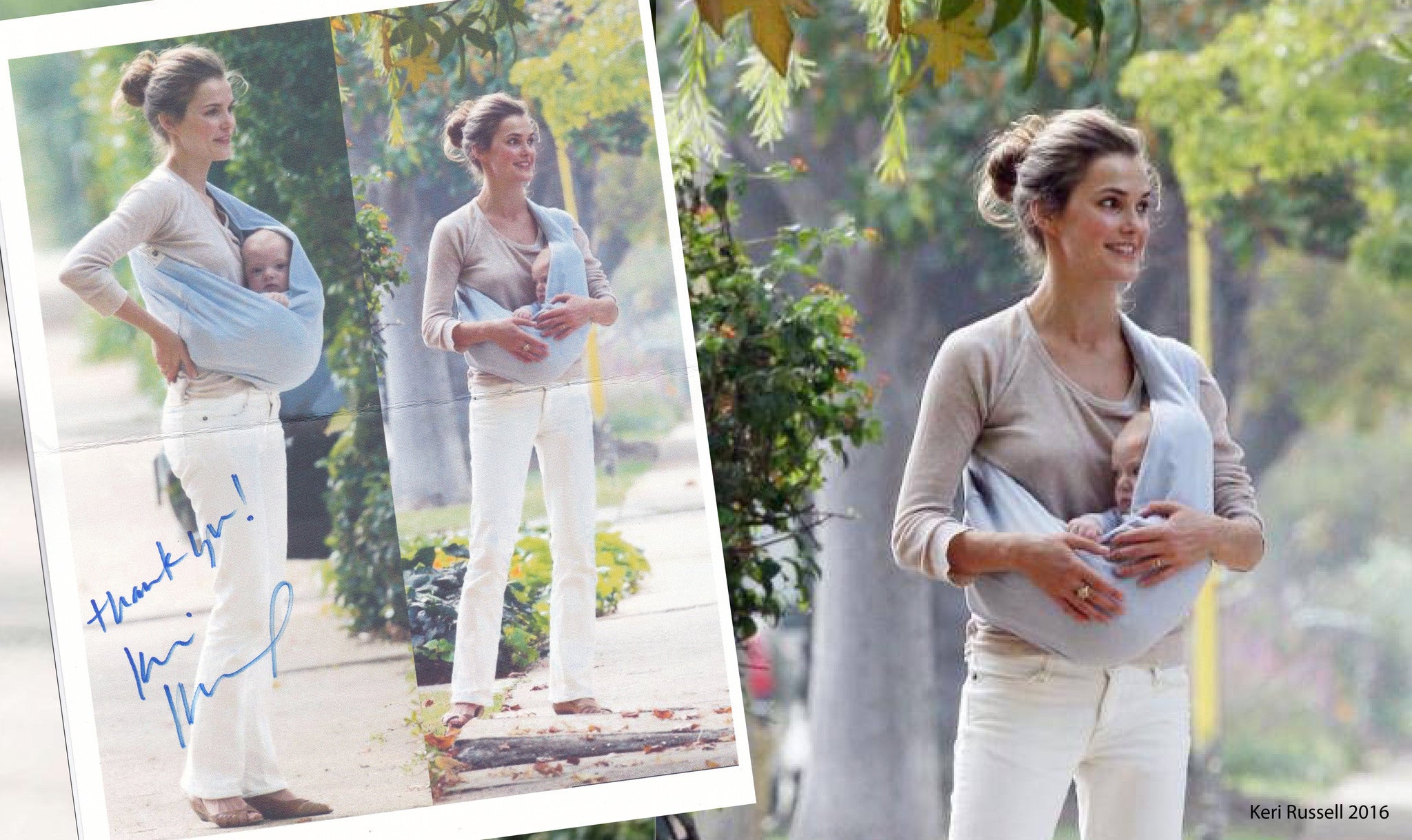Why Wear Your Baby?

Babies who enjoy a greater amount of tactile (touching) experience have a correlated higher level of self-esteem later in life.
“The kind of tactuality [another fancy word for touching] experienced during infancy and childhood not only produces the appropriate changes in the brain, but also affects the growth and development of the end organs in the skin. The tactually deprived individual will suffer from a feedback deficiency between skin and brain that may seriously affect his development as a human being."
“Bodily connectedness is the basis of the interconnectedness with others that we call sociality, and this is brought about by the closeness of mother and child in infancy. Such a close bodily relationship is the basis of good feelings about oneself, and the feeling of bodily connectedness leads to a feeling of self-esteem. Fundamentally the source of self-esteem is love. The infant uses its body to express its love and emotions."
“In a study of the relationship between self-esteem and tactuality, Drs. Alan F. Silverman, Mark E. Pressman, and Helmut W. Bartel, utilizing eighty male and female students, found that the higher the subject’s self-esteem, the more intimate he or she was in communicating through touch, especially when communicating with a female.” (265)
Babies kept in close contact sleep better.
“Anna Freud has commented on the close interrelation between the needs for sleep and for cutaneous [skin] contact, ‘falling asleep being rendered more difficult for the infant who is kept strictly separated from the mother’s body warmth.’ Ms. Freud also draws attention to interrelation between sleep and passive body movement – that is, rocking.
The relaxed child sleeps, the troubled child suffers from disturbed sleep. Normal sleep is a stimulus barrier. Disturbed sleep is a condition of vulnerability to internally originating excitements. Children who have been briefly separated from their mothers will, during the period of separation, suffer from disturbed sleep.
As Heinicke and Westheimer state in their book on the subject, ‘We find that not only is the most intense fretting for the parents concomitant with the maximum sleep disturbance, but… disturbances in sleep are directly connected with longing for the parents.’ After the third day there would be a pronounced decline in the sleep disturbances of these children, but difficulties in falling asleep and fear of being left alone were noticeably frequent.
Furthermore, ‘more of the children had persistent sleeping difficulties during the period following reunion (or its equivalent) than did those who had not been separated.’ The separations of these two-year-old children lasted from two to twenty weeks. At some point during the first twenty weeks after reunion, seven of the ten children who had experienced separation had noticeable difficulty in falling asleep or remaining asleep, or both. The duration of the sleeping difficulties persisted from one to twenty-one weeks, with the median at four weeks."
“Such findings strongly suggest that early interference with the normal mothering process, not only after the infant has made strong identifications with the mother, but even before, may seriously affect the individual’s ability to fall asleep or remain asleep. And that, in early infancy especially, the mother’s holding, carrying, cuddling, and rocking of the infant constitute acts which play a significant role in the development of later sleep patterns that may persist throughout life."
“Deprivation of the tactile need, like deprivation of any other need, causes the infant distress, a separation anxiety. It will therefore sound the distress signal designed to compel attention to its need, by crying. Aldrich and his co-workers found that among the less generally recognized causes of crying in infants is the need for fondling and rhythmic motion. These investigators found a constant relationship between the amount and frequency of crying and the amount and frequency of nursing care: the more care, the less crying. Infants will continue to cry even when they see that they are being approached or when the mother calls to them. Such infants, however, will cease crying immediately when picked up and fondled. Affectionate tactile stimulation is clearly, then, a primary need, a need which must be satisfied if the infant is to develop as a healthy human being.
“And what is a healthy human being? One who is able to love, to work, to play, and to think critically and unprejudicedly.” (196)
Touching from close proximity to the parent improves immune function.
“Surveying the research studies on animal and human responses to touching, one is impressed by how frequent are the marked advantages in health, alertness, and responsiveness of those who have been ‘handled’ as compared with those who have received minimal or no handling. Weininger, in an early unpublished study of ten infants beginning at ten weeks of age, whose mothers were taught to stroke their infants’ backs, reported that at six months of age these infants had fewer sniffles, colds, vomiting, and diarrhea than the infants in the control group, whose mothers had not been taught to stroke their infants. What is becoming increasingly evident is that underlying these and many other differences are significant changes in the structure and interrelated functions of the nervous and immunological systems."
“The mounting evidence that the skin has an immunologic function has recently been confirmed by a number of independent investigators. The skin, it has been found, more particularly its most superficial layer, the epidermis, produces a substance immunochemically indistinguishable from thymopoietin, the hormone of the thymus gland active in producing T-cell differentiation. T-cells are responsible for cellular immunity. They are called T-cells because, following their origin in the embryo from lymphocytic stem cells in bone marrow, they migrate (at least half of them do) to the thymus gland, where they are processed to become T-cells. In some way not yet understood, the thymus confers immunologic competence upon the T-cells, the ability to differentiate into cells capable of performing specific immune functions. There are thousands of such individually different T-cells, each able to react to a specific antigen and destroy it.” (198)
An early touching and visual relationship results in babies with higher IQ’s and parents with greater confidence.
“Klaus and Kennel on the basis of their own studies and a thorough examination of the work of others have concluded that early contact between mother and premature is vitally important for both. Mothers who early touched and explored the bodies of their infants showed increased commitment to the infant, greater confidence in their mothering abilities, and greater stimulating and caretaking skills, as compared with the mothers who did not have early contact with their infants. In fact, the studies had to be discontinued because the nurses found them too painful, observing as they did how unfavorable the outcome was for the later contact couples as compared with the early contact ones."
“When the children reached age three and a half, mothers who had had early contact with their prematures spent more time looking at them during feeding, and the children had significantly higher IQs, 99 as compared with 85 for late contact children.” (164)
Premature babies who experience the rocking motion similar to that which is natural while in the womb develop faster in many ways, including muscle tone, strength of grasping and weight gain.
“Studies on the effects of rocking on human infants indicate their considerable benefits. Neal studied the effects of rocking on two- to three-month prematures. These were rocked for the number of days they were premature, and it was found that the rocked prematures were significantly superior to the nonrocked prematures in the development of tracking behavior to visual and auditory stimulation, head lifting, crawling, muscle tone, strength of grasping, and weight gain. In addition no edema ever developed in the rocked prematures, whereas it did in some of the nonrocked ones. Ms. Neal suggests that rocking stimulation provided by the mother during pregnancy constitutes an important sensory input for normal development, and that prematures are unduly handicapped, following deprivation stimulation, by their premature birth."
“Woodcock observed the effects of rocking newborn female babies in a mechanical bassinet for one hour a day for six days. On the sixth day they were tested for heart-rate and acceleration responses in the rocked infants suggest an increased maturational development."
“A fascinating account of the serendipitous discovery of the benefits of rocking for seriously disturbed mental patients is reported by Dr. Joseph C. Solomon. Dr. Solomon observed that patients taken from their rooms in hospital for transfer to another town by train, though they had earlier needed to be restrained in straitjackets and muffs, became very quiet and calm as soon as the train was in motion. Solomon reasoned that, since in the womb the child is subjected to considerable passive motion, part of the human contact these patients may have missed as children was the active rocking in the mother’s arms which would, among other things, stimulate the vestibular apparatus. Purposive active motions, Solomon suggests, develop with facility and pleasure when the passive motion imparted by the mother has been satisfactorily internalized as an integrated inner function."
"Conversely, when there is little chance for the internalization of the passive movements derived from the mother, the active rocking becomes a habitual device for self-containment. It is a method of defending the formative ego against the feeling of being abandoned. This follows the principle of Newton’s Second Law. If you actively push against something, it is as though something is pushing against you. In this way the infant accomplishes the goal of not feeling completely alone. It is as though somebody is always there. As such it is another self-containment device similar to thumbsucking, the security-blanket, nail-biting…[etc]." (160-161)
Babies do not develop a habit of needing to be rocked to sleep.
“It is absurd to suggest that the cradle is harmful because the infant will develop the habit of having to be rocked before it will be able to fall asleep. If cradle rocking is habit-forming, so is breastfeeding or bottlefeeding. Yet children are weaned from breast or bottle, unless it is done too suddenly, without any serious difficulty or after effects. Millions of babies who had been rocked to sleep in cradles grew up to be adults who were able to fall asleep without needing to be rocked. Children outgrow the cradle as well as they do their baby clothes.” (158)
Baby wearing encourages parents to naturally initiate healthy touching, stroking, caressing and verbal loving; from these attentions, the baby learns healthy relationship behavior. This later translates to a whole and healthy love and sex life.
“TOUCH AND COMMUNICATION. It has been remarked that in the final analysis every tragedy is a failure of communication. And what the child receiving inadequate cutaneous stimulation suffers from is a failure of integrative development as a human being, a failure in the communication of the experience of love. By being stroked, and caressed, and carried, and cuddled, comforted, and cooed to, by being loved, the child learns to stroke and caress and cuddle, comfort and coo, and to love others. In this sense love is sexual in the healthiest sense of that word. It implies involvement, concern, responsibility, tenderness, and awareness of the needs, sensibilities, and vulnerabilities of the other. All this is communicated to the infant through the skin in the early months of his life, and gradually reinforced by feeding, sound, and visual cues as the infant develops. The primacy of the infant’s first perceptions of reality through the skin can no longer be doubted. The messages he receives through that organ must be security-giving, assuring, and pleasurable if the infant is to thrive. Even in food intake, as Brody has shown in her excellent study of mothering, ‘save under conditions of body security and comfort no infant, however hungry, appeared to enjoy his feeding.’” (216)
Montagu, Ashley. Touching, Third Edition. New York: Harper & Row, Publishers, Inc., 1986.
Why Wear Baby 2
The bodily chemicals that help us to feel love and feel good are largely stimulated through touch. Patterns are created through the loving touch, or lack of, that we receive as an infant. Our hormonal control systems and brain connections begin to permanently organize according to the human interactions we experience. A baby who does not receive adequate tactile stimulation can lose the ability to enjoy “feel good” hormones (endorphins and norepinephrine). Could this be why so many people, at this time, use alcohol and drugs to “feel good?”
“Falling in love can be intoxicating. We may feel euphoric, giddy, or forgetful as our minds become saturated with endorphins (natural opioids, pleasure hormones) and norepinephrine (adrenaline). These are our rewards for closeness. Furthermore, our bodies maintain relationships by secreting hormones such as oxytocin, prolactin, and vasopressin that make us feel good when we interact with others. Under proper conditions, this experience can emerge during parent-infant bonding. If it does, we as parents will follow the advice of our hormones and will continue to nurture our babies and maintain physical closeness with them. We ‘fall in love’ with our babies over and over as our brains undergo physical changes that reinforce parenting behaviors. The infant experiences similar hormonal responses and is permanently affected by them, becoming strongly attached to his closest caretakers."
“Humans could not have become complex, intelligent creatures without a long evolutionary social development that taught them to live with each other, learn from each other, care for each other, and depend upon each other for survival and fulfillment. This social development begins in the womb, where we become accustomed to the scent and sounds of our mother, and to the rhythm of her day. Once we are born, our hormonal control systems and brain synapses begin to permanently organize according to the human interactions we experience. We are designed to seek fulfillment for all our basic health and social needs so we can blossom into healthy, intelligent, and socially well-adapted individuals; however, we may find ourselves in an environment where our solicitations do not always receive a healthy response. When this is the case, we are programmed to become more self-centered and aggressive and less-bonded, in proportion to the severity of conditions. Toward the harsher extreme, where touching is seldom experienced and comfort rarely received, we stop secreting growth hormone and reduce brain development in order to conserve energy for a more independent survival."
“In the brains of infants and children, permanent patterns are created. Unneeded brain receptors and neural pathways are disposed of, while those appropriate to the given environment are enhanced. Early social responses, stress responses, and intellectual attention build a foundation that will guide our interaction with our environment for the rest of our lives (moderated by our own genetic slants). The initial availability of responsive care and the pursuant level of bonding with consistent caregivers determine to what degree responsible social beings will develop. While an adult may be able to be romantically neglected, deceived, or totally uninvolved without major long-term consequences, an infant’s permanent brain development is shaped by the level of attentiveness she receives from her ‘first loves."
“While many clues have been found along the way, over the last decade research has described the chemical bases of bonding reactions, confirming many people’s suspicions that attentiveness and touching enhance a child’s development. Recent advances in measuring stress hormones have spurred a deluge of research into infant responses to stresses such as maternal separation. Amazingly, or perhaps not, these findings tie in very well with earlier psychological findings. By becoming familiar with baby’s biochemistry, one can clearly understand how parents’ actions can affect their children’s psychological health. Moreover, parents can better recognize their parenting instincts, plan their parenting choices, and understand the feelings of their spouse and child.” (41-42)
Time away from the mother, not comforting, and allowing a baby to “cry it out” causes stress for infants. If an infant repeatedly has high levels of stress the result can be that they will become a child that is more fearful and inhibited.
“What causes stress during infancy? Laboratory and psychology research on animal and human infants gives us many clues. Certainly, pain from unfortunate medical conditions can create stress. So would pain from sensitivity reactions to formula or to foods passed along in breastmilk. Physical abuse and extreme neglect provide a very high degree of stress, but the effects of these severe cases are not the point of this text. Even short-term separation from mother leads to elevated cortisol in infants, indicating stress. In fact, after one full day of separation, infant rats already show altered brain organization of chemical receptors. A similar rat study revealed that one day without mother actually doubled the number of normal brain cell deaths."
“Animal findings demonstrate that isolation from mother, decreased skin stimulation, and withholding of breastmilk have biochemical and permanent brain consequences. Correlating these findings with human behavioral research suggests which events lead to chronic stress and its permanent consequences:
- allowing a child to ‘cry it out’ without parental attention and affection
- not feeding the child when hungry
- not offering comfort when the child is disturbed or distressed
- limiting body contact during feeding, throughout the day, and during stressful parts of the night
- low levels of human attention, stimulation, ‘conversation,’ and play
When these occur regularly, they can lead to early chronic releases of high levels of stress hormones, as well as low expression of favorable hormones, as previously discussed. All these practices have been promoted during the last century in the form of scheduled feedings, ‘don’t spoil the child,’ bottle feedings, which lead to propped bottles, and physical separation during the day and night."
“While it is evident that genetic makeup and life experiences influence behavior, it has been demonstrated that experiences during infancy have the strongest and most persistent effect on adult hormone regulation, stress responses, and behavior. Research has demonstrated that high levels of early physical contact and maternal responsiveness can even mitigate genetic predisposition for more extreme stress reactions."
“Biological psychology researcher Megan Gunnar and her colleagues did infant studies that confirmed animal research finding. In their work, infants three months of age who received consistent responsive care produced less cortisol. Also, eighteen-month-olds classified as insecurely attached (who had received lower levels of responsiveness) revealed elevated levels of stress hormone. These same children at age 2 continued to show elevated levels of cortisol and appeared more fearful and inhibited. Again, these children were those who had been classified as having lower levels of maternal responsiveness. Other investigations have confirmed these findings. Dr. Gunnar reports that the level of stress experienced in infancy permanently shapes the stress responses in the brain, which then affect memory, attention, and emotion.” (59-61)
In a study that gave mothers baby slings and instructed them to increase the amount of time that they carried their baby, the babies cried 43% less, fussed less, and ate more contently.
“Infants around the world are carried much of the day, either in the arms, in variously fashioned slings, or wrapped closely to the back as mother works in the field. Carrying provides stimulation through motion, known as ‘vestibular’ stimulation, and allows babies and children to observe mother’s activities and converse with her. Infant carrying also renders soothing through exposure to mother’s odor, close body contact, body warmth, and body sounds, as well as with the motion."
“When U.S. mothers in an experiment were given baby slings and instructed to increase infant carrying time, it was found that their infants were more securely attached to their mothers at 13 months of age than those who were simply given baby seats. In another study that induced increased carrying for infants, the babies cried 43% less, fussed less, and ate more contently. Yet, it has been shown that increased carrying may not reduce the crying in infants who have colic. This refers to the colic with cries related to pain, as opposed to extended crying due to other reasons. If a food reaction or other disorder is occurring, carrying may provide support, but it does not make a painful problem go away.” (80)
Palmer, Linda Folden. Baby Matters: What Your Doctor May Not Tell You About Caring for Your Baby. Lancaster, OH: Lucky Press, LLC, 2001.



